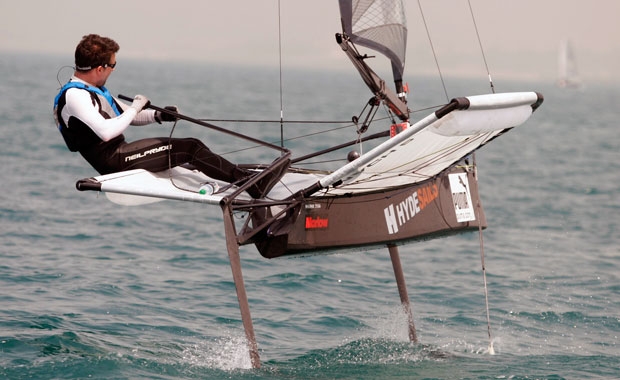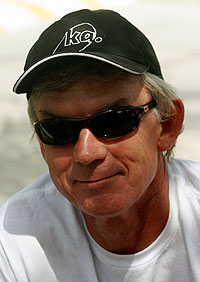
Puma Moth Worlds - some gizmos
While all the top boats at the Puma Moth World Championship are Mach 2s, there are little tweaky variations between the boats.
Background

To recap a little on the basic gear - foiling Moths have inverted T-foils on their centreboard and rudder which is what gets them airborne. On the trailing edge of the lateral part of both the centreboard and rudder T-foils is a small adjustable flap to accentuate the lift characteristic of each foil. The one on the rudder is operated via a motorcycle-style grip at the end of the tiller. The one on the centreboard is automatically adjusted by the ‘wand’ sensor that dangles from the bow, via a push rod connecting the top of the wand to the top of the lever mechanism within the centreboard. So when the bottom of the wand meets a wave, it lifts the wand, this moves the pushrod and in turn the lever within the centreboard causing ‘more flap’ to be applied, lifting the boat. When the wand falls into a trough so it drops and the flap returns to neutral.
A new introduction for 2009 was what has become known as a ‘ride height adjuster’ that adjusts the ‘overall ride’, ie more or less flap on the centreboard foil, regardless of the waves. This is typically a little spindle on top of the centreboard operated by a line from either side of the boat, although there are variations on this theme.
Tweaky bits
 Present race leader Andrew McDougall, who is also the designer of the Bladerider and its now dominant McConaghy-built successor, is using a different set of foils on his Mach 2. The rudder is supposedly smaller than the typical Mach 2 foil, and a theory going around the fleet is that the changes are more significant than McDougall is letting on.
Present race leader Andrew McDougall, who is also the designer of the Bladerider and its now dominant McConaghy-built successor, is using a different set of foils on his Mach 2. The rudder is supposedly smaller than the typical Mach 2 foil, and a theory going around the fleet is that the changes are more significant than McDougall is letting on.
“I have been doing some really minor tweaks to the foils – less than 0.5mm,” says the uber Moth designer. “I have spent a huge amount of time on the computer with these foils, so when we really started sailing a lot I thought we should revisit it. It is really hard getting it right – that’s why it is so hard to build the thing. Just the way you sand it can make a big difference...”
Following on from the Bladeriders foils, the development set McDougall bought to the Worlds two years ago in Weymouth, to the Mach 2 and now these, his latest foils are his fourth generation Moth foils.
McDougall says that because he can’t afford to take foils out of the McConaghy production line – the foils take longer to build than the boat itself... –he typically gets rejects and rejigs those. As to the differences to the regular Mach 2 foils, he claims: “You couldn’t visually see it. It is amazing when you get on the computer and start analysing this stuff and see what such minor stuff is doing. It is something like 0.3deg of twist in the foils - and you don’t get it until you start doing some massive numbers on it and just going through the motions.”
McDougall says that he is always thinking of new ideas for the foiling Moth, but isn’t about to do a ‘Mach 3’. He says it is more likely they’ll come out with a new set of foils instead as an interim step. “This has really proved to me that making subtle differences is enough gain. The hull – I could see for a heavier guy it could be a bit different. I thought I designed it for my weight but I think it is designed for a lighter guy,” he says of the Mach 2.
The problem with the foils is that they are highly intricate and require real precision in their build. The front foil is wafer thin, but still has 85 pieces of carbon that go into it. Thus it is hard simply to knock up new experimental sets. “The moulds are complicated - particularly the front foil with the flap because we mould the whole thing in one piece with the flap in. We take off the flashing, drill the hole for the bolt and you’re done.”
Over his time in the Moth class, McDougall says he has tried lots of tweaky bits. Considerable development work has been carried out over the years in the class with the wand mechanism and its linkage to the foil. MacDougall says he has tried wands with an adjustable length, although he says now he typically has one wand length for a whole series.
Aside from being ‘the’ designer of foiling Moths, MacDougall also owns KA Sails and has a new sail which he has with him, but has yet to use at this World Championship. Moth Sails are limited to 8sqm which he reckons is at the bottom end of what you need. “This is the first time I might be tempted to use two different sails mainly because I want to experiment. Typically I want to be able to rig my boat in the morning and that’s it – no changes between a 25 knots day and this. But for higher wind I’d like a sail which is more bladed out like a windsurfer’s.”
Intriguingly the two top boats at present in the Puma World Championship are both being raced by sail makers. Second placed Mike Lennon runs Hyde Sails in the UK. He is of course running his own Hyde mainsail which is a bit deeper, particularly in the head, than the opposition. Hyde sails are also being used by Tim Penfold and young Scot Dougie Imrie.

Aside from having his own sail, Lennon also has one of the most tweaky Moths in the class. He claims the right to have been the first person in Europe to use a ‘ride height adjuster’, made one of the class-wide must-have items following Bora Gulari’s World Championship win in The Gorge last year using one. Almost all of the top 20 or so boats now have them, with minor variations between each.

Where Lennon’s boat is unique is in a return to having a length adjuster on the wand [as MacDougall mentioned] with elastic pulling it down and a line pulling it up. The maximum difference in length is about 0.3m, although Lennon says typically he uses much less than this.
“The problem with using the ride height adjuster is that the wand ends up swung further aft and when you adjust drop the ride height typically you are doing it because it is big waves. The problem with the wand going back – it is not feeling waves until the bow has gone through them. So if I want to keep my wand forward so I just change the wand length.
The ride adjuster can also be used because the wand is normally slung off the starboard side of the bow it has a different height on each tack.
“The other thing that happens is that as you increase the wand length you reduce the gearing. If you have a short wand it is very effective, but it has got to move through a much bigger arch when it is long, so you reduce the gearing again by having a longer wand.”
In addition Lennon’s Moth also has an adjustable rig tensioner on its forestay. “All Mach 2s have the tube [the line goes through to run aft to the cockpit] but no one uses them. This is nice because when the wind comes up a bit you just let it off a bit. It is more to do with balance than anything else because as you drop the mast back the boat gets a bit more feel in the rudder.”
Sailing skill
Of course tweaky bits are all very well, but the foiling Moth is a very hard boat to master across the wind conditions and the 6-10 knot range we have seen so far and are likely to be seeing for the rest of this Puma World Championship is the hardest as particularly the lower end of this is where Moth are on the cusp of foiling.
The general consensus here in Dubai is that the skill is ever increasing across the fleet. As Simon Payne puts it: “People’s boat handling is better. We have less people capsizing and more people racing the boat and tactically people are paying more attention to that because sailing the boat is now second nature to them.”
But there is still a massive range of skill levels, and this is really evident in the 20-30 degree variation in angles of boats coming off the line, how high they can point upwind and how low downwind.
One of the biggest contributing factors is certainly weight of the crew – bear in mind a Moth all-up weighs just over 30kg (one bubble-wrapped up example was transported here as its owner’s luggage when they flew out – and they didn’t have to pay any excess...). But judging from the range of crew weights of those who seem to be successful we reckon it is more down to skill, and then gear.
Andrew MacDougall shares his insight: “The biggest thing about staying in the air, is flow and having the sail completely even and every part of it just completely flowing. I look at pictures of myself when I’m sailing in light wind I am always looking up, constantly keeping flow over the sail. And the same with the foils, although you can’t see them – you have to feel that. I had a sail the other day which had a tiny seaming error in it – and I couldn’t get foiling. One batten was a little bit off and the loss from having it wrong was so extreme.”
He also says it is about playing the percentages – like any racing, only in the case of the Moth they can be more extreme. “‘Am I going to send the boat really fast or am I going to play conservative to play it safe’? There are so many things for safety – like going upwind, I have two separate modes where I am more upright, the sail’s fuller, and then there is another mode when there is enough consistent wind - and it doesn’t have to be much, 6-7 knots – I can blade the sail out, lean it to windward and just send the thing, you are getting rid of all the drag... But if you are wrong and the wind drops to five knots, and you are heeled over with nothing in the sail, you are gone...you have to let everything off and get the boat upright and it takes forever. So you are have playing this thing of ‘fast or safe’.”
Mike Lennon success in marginal foiling conditions correlated directly with the weight of the crew, but it is also down to practice – he was out practicing in these conditions over the winter in the UK. But he also cites getting the gearing on the wand/foil mechanism right. “The slower you make the gearing, the less aggressively the flap moves, so I am using a very light gearing so the flap moves very slowly so in light airs as you try to lift up the flap is not coming off very quick, so it helps you lift off early.”













Latest Comments
Add a comment - Members log in